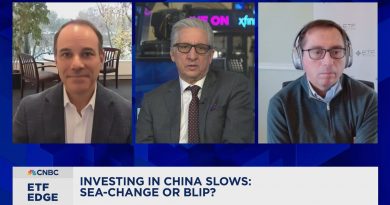China’s economy grows 4.8% in third quarter as expected, but investment sees ‘rare and alarming’ drop
China Shipping containers are seen at the port of Oakland as trade tensions continue over U.S. tariffs with China, in Oakland, California, on May 12, 2025.
Carlos Barria | Reuters
BEIJING — China’s economy grew 4.8% in the third quarter from a year earlier, the slowest pace in a year but in line with analyst expectations despite the ongoing real estate slump.
Fixed-asset investment, which includes real estate, unexpectedly contracted 0.5% in the first nine months of the year as spending on infrastructure and manufacturing slowed. Analysts polled by Reuters had forecast a 0.1% growth.
Property investment extended its decline, sliding 13.9% in the year through September, compared with a 12.9% drop during the first eight months of the year.
The drop in fixed-asset investment is “rare and alarming,” Zhiwei Zhang, president and chief economist at Pinpoint Asset Management, said in a note. He warned that fourth-quarter GDP growth faces downward pressure.
The last time China recorded a contraction in fixed-asset investment was in 2020 during the pandemic, according to data going back to 1992 from Wind Information.
“Weakness in real estate investment may persist for a longer period than previously anticipated,” Bruce Pang, adjunct associate professor at CUHK Business School, said in Chinese, translated by CNBC.
“This could represent a structural restructuring, and it’s possible that investment will never return to its prior levels,” he said. “In this context, China needs to consider how to leverage investment from other sectors to fill the investment gap.”
Industrial production climbed 6.5% in September, topping expectations for a 5% increase and up from 5.2% growth in the previous month.
Excluding property, fixed-asset investment for the first three quarters of the year rose by 3%, down from 4.2% as of August, according to official data. Private sector investment outside real estate rose 2.1% for the year through September, also slower than the 3% recorded as of August.
“The weakness in investment spending, especially by the private sector, reflects a lack of confidence in the economy’s growth prospects as well as in government policies that could support growth,” Eswar Prasad, a professor of economics at Cornell University, said in an email.
Modest consumer spending
Retail sales rose 3% in September from a year ago, matching analyst forecasts. In a sign of waning support from China’s consumer goods subsidy program, sales of home appliances rose by a modest 3.3% in September, compared with a surge of 25.3% for the first three quarters of the year.
“I don’t think we could stimulate domestic demand without stabilizing the housing market first,” Dan Wang, Eurasia Group, said Monday ahead of the data release on CNBC’s “Squawk Box Asia.”
China’s Statistics Bureau said disposable income for city residents rose 4.5% in the first three quarters of the year after adjusting for price changes, while rural residents saw a 6% increase.
The urban unemployment rate ticked down to 5.2% in September from 5.3% the previous month.
However, retail sales slowed from 3.4% year-on-year growth in August, while third-quarter GDP slowed from 5.2% growth in the previous quarter.
Official data for September also showed continued resilience in China’s exports despite tensions with the U.S.
The core consumer price index, which strips out food and energy, rose at its fastest pace since February 2024. But headline inflation fell 0.3%, missing expectations as deflationary pressures persisted.
Earlier Monday, China kept its benchmark lending rates unchanged for a sixth-straight month, in line with expectations, with the one-year loan prime rate at 3% and the five-year rate at 3.5%.
China’s top leaders are meeting from Monday to Thursday to discuss policy and development goals for the next five years.
Beijing has sought to shift the economy toward domestic consumption for growth, while developing homegrown technology in the face of rising U.S. restrictions.
“China should step up its efforts in tech, but we also firmly believe the so-called old economy will remain the backbone of the economy for the foreseeable future,” Nomura Chief China Economist Ting Lu said in a note last week. “Beijing will have to clean up the property sector mess in 2026-30 for several reasons.”
He noted that real estate remains second only to exports in contributing to China’s GDP, while about half of household wealth is in property, and that the sector still accounts for about 18% of local government revenue. Overinvestment in new industries such as electric vehicles “has already become counterproductive,” Lu said.





